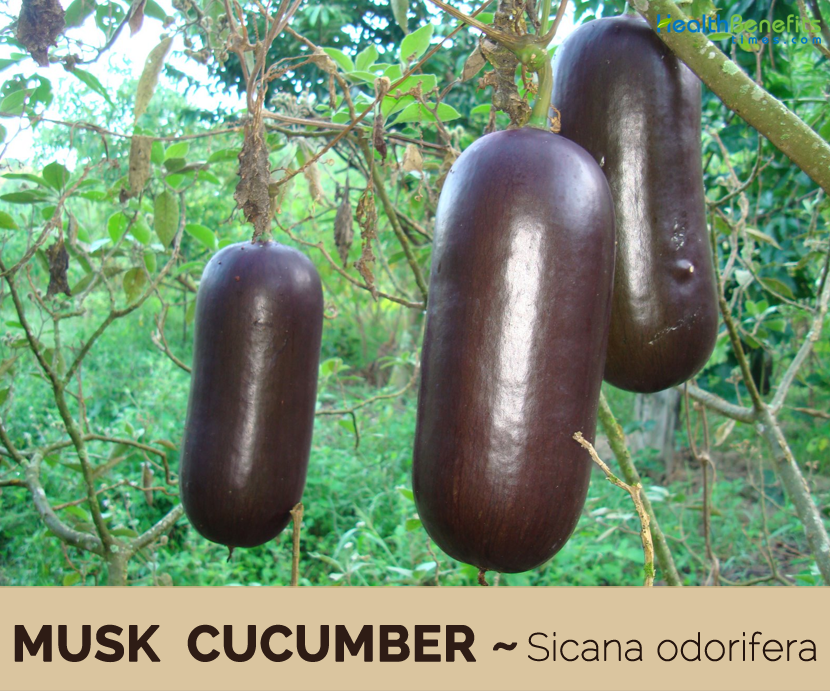| Musk Cucumber (Cassabanana) Quick Facts | |
|---|---|
| Name: | Musk Cucumber (Cassabanana) |
| Scientific Name: | Sicana odorifera |
| Origin | South America |
| Colors | Green to orange-red, maroon, dark-purple |
| Shapes | Ellipsoid or nearly cylindrical, sometimes slightly curved; 12 to 24 in (30-60 cm) in length, 2 3/4 to 4 1/2 in (7-11.25 cm) thick, hard-shelled, |
| Flesh colors | Orange-yellow or yellow |
| Taste | Delicious, melon-like taste |
| Major nutrients | Vitamin C (15.44%) Vitamin B1 (4.83%) Vitamin B3 (4.79%) Iron (4.13%) Phosphorus (3.50%) |
Plant Description
Musk cucumber is a large, herbaceous perennial, fast growing vine that grows about 50 ft. (15 m) or more in height, climbing with four-part adhesive tendrils equipped with adhesive discs that can adhere tightly to the smoothest surface. The plant can adapt to a variety of environments and can be grown in temperate climates. It does well on an acidic mix of sand (or perlite) and rich compost. Stem is green, thick, sulcate, puberulent or glabrescent; tendrils axillary, 5-fid, 9-11 cm long.
Leaves
Leaves are gray-hairy, rounded-cordate or rounded kidney-shaped, to 1 ft. (30 cm) wide, deeply indented at the base, 3-lobed, with wavy or toothed margins, on petioles 1 1/2 to 4 3/4 in (4-12 cm) long, slender, canaliculate or slightly winged, villous. Upper surface of the leaf is dark green, slightly shiny, glabrous; lower surface pale green, with prominent venation, glabrous.
Flower & Fruit
Flower is white or yellow, urn-shaped, 5-lobed, solitary, the male 3/4 in (2 cm) long, the female about 2 in (5 cm) long. Fruit is ellipsoid or nearly cylindrical, sometimes slightly curved; 12 to 24 in (30-60 cm) in length, 2 3/4 to 4 1/2 in (7-11.25 cm) thick and are hard-shelled. The fruit is green when young turning to orange-red, maroon, dark-purple with tinges of violet, or entirely jet-black with a waxy appearance. The fruit takes a long time to mature, and requires high temperatures to ripen. The rind is tough, smooth and glossy like that of a watermelon, and inedible. Inside, the fruit is the firm flesh which is yellow-orange and there is a large seed cavity that runs along the length of the fruit. The seeds are numerous, asymmetrically ovate, compressed, with the margin darker, 13.5-15 mm long and are inedible. Cassabanana has delicious, melon-like taste. The sweet, aromatic, yellow-to-orange flesh of the mature fruit is eaten raw or made into preserves. The immature fruit can be cooked as a vegetable.
History
Cassabanana is believed native to Brazil but it has been spread throughout tropical America. Historians have proof that it was cultivated in Ecuador in pre-Hispanic times. It was first mentioned by European writers in 1658 as cultivated and popular in Peru. It is grown near sea-level in Central America but the fruit is carried to markets even up in the highlands. Venezuelans and Brazilians are partial to the vine as an ornamental, but in Cuba, Puerto Rico and Mexico it is grown for the usefulness of the fruit.
In 1903, O.F. Cook saw one fruit in a market in Washington, D.C. The United States Department of Agriculture received seeds from C.A. Miller, the American Consul in Tampico, Mexico, in 1913. H.M. Curran collected seeds in Brazil in 1915. Wilson Popenoe introduced seeds from Guatemala in 1916. The author brought seeds from Rio Piedras, Puerto Rico, to the Agricultural Research and Education Center, Homestead, in 1951. A resulting vine grew to large size but produced a single 2 ft (60 cm) fruit. Dr. John Thieret, formerly Professor of Botany at Southwestern Louisiana University, says that the Cajuns in the southern part of that state grow the cassabanana for making preserves. Verrill stated in 1937, “The fruit is now on sale in New York markets.”
Nutritional value of Cassabanana
Apart from their delicious, melon-like taste, Cassabanana is a good source of nutrients, vitamins and minerals. Consuming 100 gram of Cassabanana offers 13.9 mg of Vitamin C (Ascorbic acid), 0.058 mg of Vitamin B1 (Thiamin), 0.767 mg of Vitamin B3 (Niacin), 0.33 mg of Iron,24.5 mg of Phosphorus,1.1 g of Total dietary Fiber, 0.035 mg of Vitamin B2 (Riboflavin), 21.1 mg of Calcium, 0.145 g of Protein and 0.02 g of Total Fat (lipid).
Traditional uses and benefits of Cassabanana
- It is used as a medicine in Belize for treating head colds and high blood pressure.
- Seeds are used in traditional medicine in Brazil & Puerto Rico to treat sore throats & fevers.
- Seed infusion is taken in Brazil as a febrifuge, vermifuge, purgative and emenagogue.
- Leaves are used for STDs for uterine hemorrhages and other complaints.
- In Yucatan, a decoction of leaves and flowers is prescribed as a laxative, emenagogue and vermifuge.
Culinary Uses
- Flesh of the mature fruit is eaten raw or made into preserves.
- Immature fruit can be cooked as a vegetable or in soup and stews.
- It is mainly used in the kitchen for making jam or other preserves.
- Flesh can also be used in desserts and confections.
- Pulp is steeped in water overnight and the resulting liquid is drunk.
Other facts
- Cassabanana remains in good condition for several months if kept dry and out of the sun.
- People like to keep the fruit around the house, and especially in linen- and clothes-closets, because of its long-lasting fragrance, and they believe that it repels moths.
- It is also placed on church altars during Holy Week.
- People use to wear a necklace of the seeds around the neck.
- During Holy Week (Easter) the fruit can be found decorating church altars too.
Precautions
- Seed is poisonous if ingested.
- Parts of plant are poisonous if ingested.
References:
http://eol.org/pages/484693/overview
https://www.itis.gov/servlet/SingleRpt/SingleRpt?search_topic=TSN&search_value=505199#null
https://davesgarden.com/guides/pf/go/2775/
https://npgsweb.ars-grin.gov/gringlobal/taxonomydetail.aspx?id=33879
https://plants.usda.gov/core/profile?symbol=SIOD
https://en.wikipedia.org/wiki/Sicana_odorifera
https://www.hort.purdue.edu/newcrop/morton/cassabanana.html
Comments
comments
